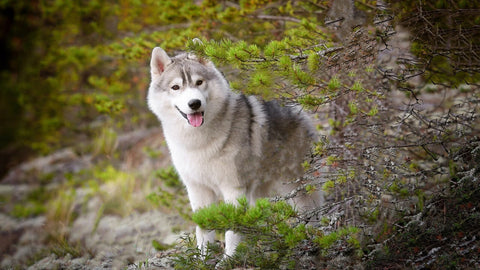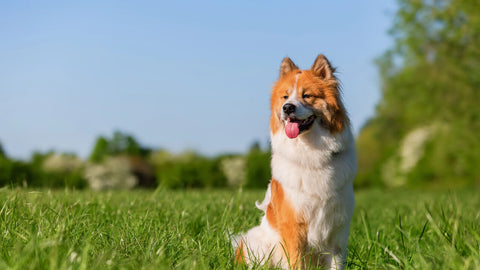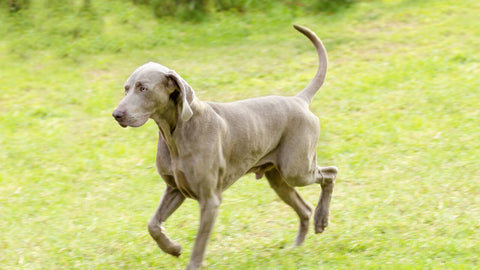Contents
- Introduction to the Husky
- Appearance of the Husky
- Coat and Colours of the Husky
- How big can a Husky get
- The Character of the Husky
- Training the Husky
- For whom is the Husky suitable
- Is the Husky a family dog
- Care of the Husky
- Nutrition of the Husky
- How much does a Husky shed
- How old does a Husky get
- Typical diseases of the Husky
- How much does a Husky puppy cost
- What to look for when buying a Husky
- Husky profile
Introduction to the Husky
The Siberian Husky is one of the world's most fascinating dog breeds, known for its wolf-like appearance, endurance and friendly nature. Originally bred by the nomadic peoples of Siberia to pull sleds and serve as working dogs, the Husky has established itself worldwide as a loyal companion and popular family dog. With its lively energy, intelligence and charming nature, it is a breed that delights both experienced dog owners and novices.
Appearance of the Husky
The Husky is characterised by its striking, wolf-like appearance. It has an athletic, well-proportioned build with a strong, but not too massive, physique. Their eyes are often almond-shaped and can be blue, brown or even both colours (one eye blue, the other brown). The upright, triangular ears and the bushy tail, which is often carried over the back, enhance their wild yet friendly appearance. Their gaze is alert and lively, reflecting their alert and curious nature.
Coat and colours of the Husky
The Husky's dense double coat consists of a soft undercoat and a coarser top layer. This coat protects them from extreme weather conditions, both in summer and winter. Huskies come in a variety of colours and patterns, including black and white, grey and white, red and white, and pure white. The markings on their faces also vary greatly and contribute to their individual appearance. Typical features are a white face mask and symmetrical markings around the eyes.
How big can a husky get?
A fully grown Siberian Husky reaches a shoulder height of 50 to 60 cm, with males usually being slightly larger than females. Males weigh between 20 and 27 kg, while females usually weigh between 16 and 23 kg. Despite its muscular and powerful build, the Husky appears elegant and agile.
The character of the Husky
The Husky is known for its friendly, even-tempered and sociable character. It is an extremely lively and active dog that needs a lot of exercise and mental stimulation. Huskies are very social animals and love the company of people and other dogs. Their independent spirit and intelligence sometimes make them challenging to train, but with patience and consistency, they are easy to manage. Aggressiveness is not typical of Huskies; instead, they are curious, playful and adventurous.
Training a Husky
Training a Husky requires patience, consistency and an understanding of the breed's independent nature. They are intelligent but also headstrong dogs that often have a mind of their own. It is important to socialise them early on and to set clear rules to avoid unwanted behaviour. Huskies respond well to positive reinforcement, such as rewards and praise. Since they were originally bred as sled dogs, it is important to keep them physically and mentally active to prevent frustration and boredom.
Who is a husky suitable for?
A husky is ideal for active people or families who spend a lot of time outdoors and enjoy exercise. It is not a dog for couch potatoes, but requires a lot of exercise and activity. People who enjoy jogging, hiking or other outdoor activities will find a Husky to be the perfect companion. Even experienced dog owners who are aware of the challenges of a demanding upbringing will enjoy this breed.
Is the Husky a family dog?
Yes, the Husky can be an excellent family dog if socialised and trained properly. They are playful, friendly and patient, even when dealing with children. However, children should learn to treat the dog with respect, as huskies need their space and can sometimes be impetuous. Due to their high energy levels and their intelligence, it is important that the whole family is willing to actively engage with the dog.
Husky care
Grooming a Husky involves intensive brushing, especially during the coat change (once or twice a year), to remove dead hairs and thin the undercoat. Regular brushing prevents matting and reduces the amount of hair the dog loses. The ears should be checked regularly and cleaned if necessary, and the claws must also be cut regularly to prevent injury. A bath is rarely necessary as the Husky's coat is dirt-repellent.
Nutrition of the Husky
Huskies have relatively low feeding needs compared to their size and activity level. A balanced diet rich in protein and healthy fats is important to maintain their energy and good health. High-quality dry food or a mixture of wet and dry food is suitable. Care should be taken to ensure that the husky is not overfed, as this breed tends to become obese if it does not get enough exercise.
How much do huskies shed?
Huskies shed a lot of hair when they are moulting, which happens twice a year – in spring and autumn. During this time, they lose a large amount of undercoat, which makes regular and intensive brushing necessary. Outside of these phases, the loss of hair is moderate, but still noticeable. For people who don't like dog hair in the house, the Husky is therefore less suitable.
How old does a Husky live to be?
The average life expectancy of a Siberian Husky is around 12 to 15 years. With good care, regular veterinary check-ups and a balanced diet, Huskies can reach a ripe old age. Some Huskies even live longer and remain active and healthy well into old age.
Typical diseases of the Husky
Like many breeds, the Husky has a predisposition for certain health problems. These include hip dysplasia, eye diseases such as cataracts or progressive retina atrophy (PRA), and zinc deficiency dermatoses, which can cause skin problems. Regular health checks are important to detect and treat these conditions early.
How much does a Husky puppy cost?
The cost of a Husky puppy can vary greatly depending on the breeder, pedigree and region. On average, the price is between CHF 1000.00 and CHF 2000.00. Reputable breeders who pay attention to the health and well-being of the animals often charge higher prices because they invest a lot in the health, socialisation and care of the puppies.
What should you bear in mind when buying a Husky?
When buying a Husky puppy, you should make sure that the breeder is reputable and values the health of the parent animals. A responsible breeder will be happy to answer questions and show the breeding animals and the puppies‘ environment. It is also important to have the parents’ health checked, especially for hip dysplasia and eye diseases. The puppy should be healthy, well socialised and accustomed to people.
Characteristics of the Husky
Breed: Siberian Husky
Country of origin: Siberia, Russia
Size: males 53-60 cm, females 50-56 cm
Weight: males 20-27 kg, bitches 16-23 kg
Life expectancy: 12-15 years
Coat: Double coat, dense undercoat, medium length
Colours: Various colours and patterns, e. e.g. black and white, grey and white, red and white, pure white
Eye colour: Blue, brown, one blue eye and one brown eye
Character: Friendly, active, intelligent, independent
Grooming: Medium to high (especially during the coat change)
Training effort: High (due to their intelligence and independence)
Suitable for: Active families, sporty people, people with dog experience
Origin: Bred by the Chukchi in Siberia for sledding




Comments (0)
There are no comments for this article. Be the first one to leave a message!